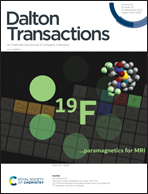Color-tunable emissions realized by Tb3+ to Eu3+ energy transfer in ZnGdB5O10 under near-UV excitation†
Abstract
Photoluminescent (PL) energy transfer (ET) between two typical rare earth activators Tb3+ and Eu3+ is utilized to achieve color-tunable emission and the color range is apparently dependent on the ET efficiency. In the target host ZnGdB5O10 (ZGBO), the relatively low symmetric coordination environment of the rare earth cation not only suppresses the parity-forbidden law of the 4f–4f transitions of Tb3+ in the near-UV region, but also enhances the internal quantum efficiency (IQE), where the optimal IQE is 65.61% for ZGBO:0.8Tb3+. Moreover, its ET to Eu3+ is highly efficient, i.e. 94.71% in ZGBO:0.8Tb3+,0.10Eu3+, which eventually leads to a wide range of color-tunable emissions from green (0.2915, 0.5915) to red (0.6207, 0.3731). The systematic PL spectral study on Tb3+/Eu3+ singly doped and co-doped phosphors suggests that the ET mechanism takes place through the electric dipole–dipole interaction according to the Inokuti–Hirayama (I–H) model. Additionally, the in situ high temperature PL spectra indicate the very high thermal stability of ZnGd0.19Tb0.8Eu0.01B5O10, indicating that it can be a potential candidate for near-UV light emitting diode-pumped phosphors.



 Please wait while we load your content...
Please wait while we load your content...